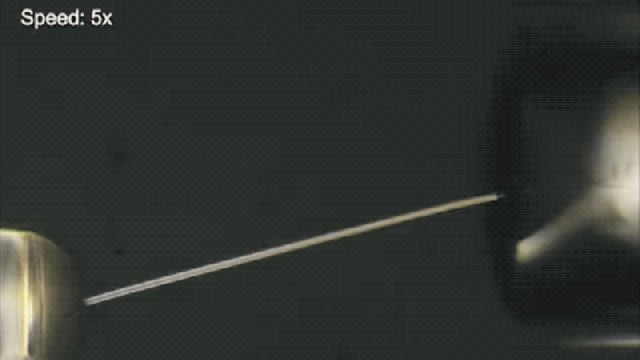New research from China shows that thin, carefully crafted strands of ice can take on surprisingly elastic properties.
As a medium, ice is very unforgiving. It melts at temperatures above freezing (obviously) and snaps instead of bending when under strain. Defects like microcracks, surface imperfections, and pores — which form during the freezing process — give ice its brittle, stubborn quality.
Such is not the case for all ice, however. Scientists in China have shown that ice, under the right circumstances, can be surprisingly flexible and springy. In tests, strands measuring just 4.4 micrometres in diameter could be bent to a near-circular shape, and when the pressure was eased, the strands returned to their original shape. Limin Tong from Zhejiang University in Hangzhou led the new research, published today in Science.
To make the ice microfibres, the team channeled water vapour into a small electrical chamber. The temperature of the chamber was cooled with liquid nitrogen. Then, a tungsten pin was placed inside and electrified to 2,000 volts, which served to attract the water vapour. Ice crystals formed on the pin, allowing the team to grow the microfibres, albeit at a very slow rate.
The scientists experimented with the chill temperatures, growing the strands between -70 to -150 degrees C. At the maximum cold temperature, the resulting microfibres showed surprising elastic properties, bending to a maximum strain of 10.9%. By contrast, normal ice has an elastic strain of 0.3%. The bendy ice approaches the theoretical limit of how flexible ice is presumed to be, at 15%, so there’s still potential room for improvement.
As an unexpected bonus, the ice was amazingly transparent, which means the microfibres could eventually be used to transmit light, similar to fibre optic cables. The scientists said this technology might eventually be leveraged to create tiny sensors capable of detecting air pollution.
“In showing that ice can reach a high level of mechanical integrity, and with high optical quality, [the team led by Tong] revealed the potential for similar improvement through appropriate processing in the behaviour of other brittle, crystalline materials,” as Erland Schulson, an engineer at Dartmouth College who wasn’t involved in the research, explained in an associated Perspectives article.
The microfibres were made from two different types of ice, each with different densities, and the strands lacked the structural defects associated with conventional ice. Their internal structure was built from single crystals with atoms arranged in a repeating, honeycomb-like pattern, as Tong told the New York Times. Together, these factors are what allow the strands to be so flexible.
It’s amazing to see what scientists are able to do with frozen water. It’ll be interesting to see if they can push the elastic limits of ice further, and approach that elusive theoretical limit.
